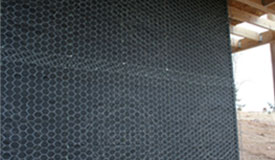You’ve put a lot of time, energy, money and love into creating the perfect home, something you can be proud of, grow old in, and pass along to future generations. It took years of work and sacrifice to get it just right, knocking down that interior wall to create an open-concept kitchen, renovating the basement into a home theatre room, landscaping your backyard to create just the right look from your new deck. Finally, it’s perfect. Except for one thing. What is that smell when you go down into the basement? And why does it feel damp? Could moisture be getting into the walls? What do you do now?
Moisture in your walls can lead to mold, basement flooding and foundation damage, all of which can lead to costly repairs and considerably lower the value of your home. The best solution is prevention. Get ahead of the problem by waterproofing the exterior of your home before moisture can take root.
Keep your eaves troughs and gutters clean
One easy way to prevent water damage is to make sure that your eaves troughs and gutters are cleaned regularly. If these get clogged, you will have standing water on your roof which can begin to seep into your walls. Having them checked in spring and fall can save you from serious problems and huge expenses down the road.
Check your exterior for proper water drainage
The next thing you can do is take a walk around your house, especially after a rainstorm, to make sure that water is draining away from the foundation and not pooling against the wall. Assuring proper drainage can go a long way towards protecting your home from water damage.
Inspect your exterior walls for cracks and faults
Once you have made sure that you are diverting water away from your house, the next thing to do is look for obvious ways for moisture to enter. If there are cracks in the cement or spaces between brickwork, they need to be dealt with before moving forward with any waterproofing work. External waterproofing treatments won’t work if there are cracks or damage in the walls. Checking for leaky pipes would also be a good idea before doing any major waterproofing work.
Waterproofing your foundation
Now that the basics are out of the way, it’s time to get down to business. The first thing you need to do is dig around the exterior to expose the base of your foundation. Then you need to examine the foundation for any cracks and repair any damage you find. Then apply a sealant all around the base of your foundation. This will catch any cracks you may have missed. Next, apply a waterproof membrane to seal against water damage and prevent future cracking of the foundation. Then install a drainage mat or dimple board, to keep moisture from collecting at the base of your wall. Finally, install weeping tiles, then back fill with gravel.
Waterproofing your home may not have the visual appeal of an open concept kitchen or a new deck and well landscaped backyard, but the peace of mind it offers you will more than pay for itself.


 Stucco or Siding?
Stucco or Siding?
